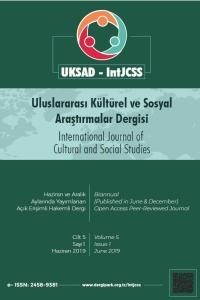Kültürel Dönemeç, Sömürgecilik Sonrası Çeviri ve Feminist Çeviri Yaklaşımlarına Babil Kulesi’nden Bakmak
Jacques Derrida, Babil Kulesi (1985) başlıklı yazısında, dildeki sözcüklerin sonsuz anlam ve bağlam içerdiğini vurgular; eşdeğerlik kavramının baştan defolu bir kavram olduğundan hareketle, her çeviri eyleminin bir yeniden yazmaya dönüştüğünü belirtir. Buna dayanarak, belirli bir dönemde belirli bir bağlam için geçerli ve uygun olan çeviri yaklaşımının, değişen koşullarla ve bakış açılarıyla sürekli olarak farklılaştığı ve her çeviri denemesinde yapıbozumuna uğradığı söylenebilir. Bu çalışma içerisinde, çeviri eylemini kültürel ve dilsel bir yeniden yazma olarak ele alan kültürel dönemeç, sömürgecilik sonrası ve feminist çeviri yaklaşımları tartışmaya açılacak, bu yaklaşımların çeviri eylemine getirdikleri yorumlar ile Derrida’nın Babil Kulesi (1985) başlıklı yazısında öne sürdüğü düşünceler arasında koşutluklar olup olmadığı tespit edilmeye çalışılacaktır.
Anahtar Kelimeler:
Jacques Derrida, Yeniden Yazma, Kültürel Dönemeç, Sömürgecilik Sonrası Çeviri, Feminist Çeviri
A Look Into the Cultural Turn, Post-Colonial and Feminist Translation From the Tower of Babel
Jacques Derrida, in his article titled “Des Tours De Babel” (1985), emphasizes that the words in the language are comprised of infinite meanings and contexts; therefore, the concept of equivalence is a defective concept, and that each translation is a rewriting. Based on this idea, the translation, which is valid and appropriate for a given context in a certain period of time, is deemed to undergo deconstruction through constantly changing conditions and perspectives, thus gradually ripping off the target text from the source text under each and every task of translation. In this study, the translational approaches of cultural turn, post-colonial translation and feminist translation, which see the translation activity as a form of cultural and linguistic rewriting, will be discussed, and the question of whether there are any parallelisms between the interpretations these approaches have brought into the concept of translation and Derrida's approach to rewriting will try to be answered.
Keywords:
Jacques Derrida, Rewriting, Cultural turn, Post-colonial translation, Feminist translation,
___
- Bassnett, S. & Lefevere, A. (Ed.). (1990). Translation, History and Culture. London: Pinter.
- Bassnett, S. & Trivedi, H. (1999). Post-Colonial Translation: Theory and Practice. New York, ABD; Londra, İngiltere: Routledge.
- Bassnett, S. (2002). Translation Studies. London, Kanada; New York, ABD: Routledge.
- Bassnett, S. (2011). Reflections On Translation. Bristol, İngiltere; Tonawanda, ABD; Ontario, Kanada: Multilingual Matters.
- Benjamin, W. (2002) [1921]. The Task of the Translator. Walter Benjamin Selected Writings Volume 1 1913-1926, s. 253-263, Massachusetts, ABD: The Belknap Press of Harvard University Press.
- Bhabha, H. K. (1994). The Location of Culture. London, Kanada; New York, ABD: Routledge.
- Castro, O. (2009). (Re-)Examining Horizons In Feminist Translation Studies: Towards A Third Wave?” MonTI, 1, s. 59-86.
- Castro, O. & Ergun, E. (Ed.) (2017). Feminist Translation Studies: Local and Transnational Perspectives. London, Kanada; New York, ABD: Routledge.
- Chamberlain, L. (1988). Gender and the Metaphorics of Translation. Signs: Journal of Women in Culture and Society, 13:3, s. 454–472.
- Derrida, J. (2007) [1985] Des Tours de Babel (Çev. Joseph Graham). Psyche: Inventions of the Other, Volume 1, s. 191-225, Kaliforniya, ABD: Stanford University Press.
- Ece, A. (2009). Sömürgecilik-Sonrası Kuramların Çeviri Eylemine Metoforik Yaklaşımları. Litera, 21:1, s. 47-58.
- Gentzler, E. (2014). Translation Studies: Pre-Discipline, Discipline, Interdiscipline, and Post-Discipline. International Journal of Society, Culture & Language, 2: 2, s. 14-24.
- Godard, B. (1984). Translating and Sexual Difference. Resources for Feminist Research 13:3 içinde s. 13-16.
- Holmes, J. S. (1988). The Name and Nature of Translation Studies. Translated!: Papers on Literary Translation and Translation Studies, s. 66-80, Amsterdam: Rodopi.
- Lefevere, A. (1992). Translation, Rewriting, and the Manipulation of Literary Fame. London, Kanada; New York, ABD: Routledge.
- Niranjana, T. (1992). Siting Translation: History, Post-Structuralism, and the Post-Colonial Context. Berkeley, Los Angeles, Kaliforniya: University of California Press.
- Robinson, D. (1998). Translation and Empire: Postcolonial Theories Explained. Manchester: St. Jerome Publishing Company.
- Schleiermacher, F. (2012) [1813]. On the Different Methods of Translating (Çev. Susan Bernofsky). The Translation Studies Reader (ed. Lawrence Venuti), s. 43–63, New York: Routledge.
- Simon, S. (1996). Gender in Translation: Cultural Identity and the Politics of Transmission. London, Kanada; New York, ABD: Routledge.
- Spivak, G. C. (1987/1988). In Other Worlds, Essays in Cultural Politics. New York, ABD; Londra, İngiltere: Routledge.
- Spivak, G. C. (2003). Death of a Discipline. New York, ABD: Columbia University Press.
- Stolze, R. (2011) The Development of Translation Studies as a Discipline – From linguistics to cognition. Revista Translatio, 1, s. 21-37.
- Toury, G. (1995) Descriptive Translation Studies – And Beyond. Amsterdam, Hollanda; Philadelphia, ABD: John Benjamins Publishing Company.
- Venuti, L. (1995) The Translator’s Invisibility: A History of Translation. London, Kanada; New York, ABD: Routledge.
- Vermeer, H. (1998). Starting to Unask What Translatology is About. Target, 10:1, s. 41-68.
- Von Flotow, L. (1997). Translation and Gender: Translating in the 'Era of Feminism'. Manchester, İngiltere: St. Jerome Publishing.
- Yazıcı, M. (2009). Translation Studies as a Fully-Fledged Discipline. Perspectives in Translation Studies, s. 6-19.
- Başlangıç: 2015
- Yayıncı: Mutlu TÜRKMEN
Sayıdaki Diğer Makaleler
Sosyal Paylaşım Siteleri ve Demokratikleşme İlişkisi: Facebook Örneği
Türkiye’nin Radyo ile Tanışması ve Türk Telsiz Telefon Anonim Şirketi
Somariah FİTRİANİ, Sherly FELİNA
Sosyal Medyada Öz-Temsil ve Ötekiliğin ‘Öteki Boyutu’: ‘Karikateist’ Toplumsalı Üzerine İnceleme
Vincent Van Gogh’un Sanatında Özdeşleyim ile Varılan Aşkınlık ve Günümüz Doğa Sanatı
